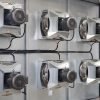Designing a fan array is a detailed process that requires a lot of steps. It sounds tedious, but it doesn’t have to be! Our ventilation experts put together this guide to highlight what to look out for when designing a fan array. Consider these seven steps to get the most efficient fan array!
1. Distance from the face of the coil.
As a rule of thumb, the distance between the inlet of the fan and the coil face should be greater than the diameter of the fan. In most cases, 24” will be sufficient. This helps prevent loss of coil efficiency or moisture carryover due to high velocity across one part of the coil. If this is not feasible, Mainstream does have solutions specifically designed for tight spaces.

2. Size of the discharge.
We recommend keeping the velocity of the air through the discharge opening under 1000 FPM. A discharge opening that is too small can add a significant pressure drop. Adding a bellmouth to the discharge opening can help reduce the pressure drop.
3. Door size and location.
Will the existing door allow adequate access, or interfere with the fan array?
- Service of the fans. Access to the downstream/leaving air side of the fan array will be required to reach the fans for service or replacement.
- Coil access. When a fan array is installed, it may cut off access to the coils. Optionally, a door can be included in the fan array itself.

4. Pressurizing the unit.
When a fan array is installed, the plenum downstream is put under positive pressure.
- Integrity of the casing. Are there concerns about the unit casing leaking, or the panels being able to withstand positive pressure?
- Door swing. Will the doors swing against the pressure? If not, safety latches should be added.
- Sealing the pressure wall. Is there a continuous drain pan extending under the fan section, or any supports or structure that could interfere will creating a tight pressure seal?
- Unit interior wall. Is it a single wall unit with insulation on the interior? The insulation will need to be peeled back to properly seal the array to the interior walls of the unit.
5. Location of the control panel.
Will the control be mounted on the exterior of the unit, or remotely? Is a NEMA 1 enclosure suitable, or is it outdoors? Will the pre-wired whips (if included) reach the panel?

6. Cooling coil face area.

The cooling coil face area is helpful for verifying the CFM, as standard air velocity over the coil/s is 500 FPM or less. If the CFM of the unit is being increased, will the velocity across the coils be too high? If so, it could result in moisture carryover and increased leaving air temperatures.
7. Are the fans being mounted on an existing concrete pad or structure?
If so, the fan array may extend off the existing pad/structure and may require the installer to build out additional support.
CFM: Volume of airflow, measured in cubic feet per minute.
CFM = FPM * sq ft of face area
FPM: Velocity of airflow, measured in feet per minute.
FPM = CFM / sq ft of face area
Want to learn more about designing a fan array? Contact the Mainstream experts today!





